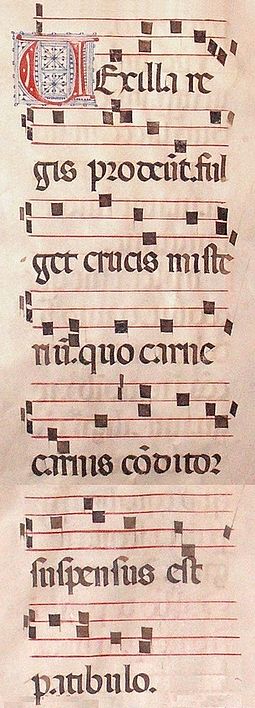Venantius Honorius Clementianus Fortunatus was a self-described wandering minstrel in Europe of the very early Middle Ages, or late Antiquity, or the inaptly-described ‘Dark Ages’, which in fact had much that was light about them. As Father Callam points out in the accompanying reflection, Venantius lived between 530 to about 600 Anno Domini. He was eventually ordained a priest, and ended up as bishop of Poitiers, but is perhaps best known in history as one of the Church’s greatest poets and hymnographers, with eleven books of poetry and panegyrics attributed to him.
For our purposes today, we turn to the Vexilla Regis Prodeunt, used for Vespers from Passion Sunday to Holy Thursday, and for the Feast of the Triumph of the Cross – see Father Callam again for the full text, or follow along with the scrolled chant version below. Translated as ‘The Royal Banner Forward Goes’, it is ideal in its original language – ‘vexilla‘ referring to all the symbols of kingship, the banners, flags, even weapons of war. But Christ’s dominion, as the Word Himself confessed, is not of this world, and his ‘weapon’ is the Holy Cross, by which He brought about our redemption.
The hymn was first sung for the solemn procession of a sizeable relic of the True Cross, on November 19th, 569, as it was brought from the East, to Tours in France, and then to the monastery of Saint Radegunda at Poitiers.
Here is the original chant version:
Next, the Vexilla in Palestrina’s incomparable polyphony, first performed in 1589:
And, finally, the arrangement of Venantius’ hymn by Anton Bruckner, the final motet the great composer ever composed, with his usual haunting, soaring harmonies, first performed on Good Friday, April 15th, 1892:











